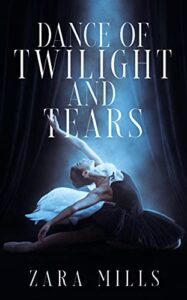Dance of Twilight and Tears
Zara Mills
FinnStar Publishing
Published January 20, 2022
Amazon | Goodreads
About Dance of Twilight and Tears
Algae and toe shoes, feathers and tutus
Behind the gilded doors of the Paris Opéra Ballet, two best friends, Madeleine and Lucie, dance the night away. But at first morning light, their human bodies transform into webbed feet, billed lips, and wings.
When enchanted, the girls are the Bois de Boulogne’s famous black and white swans. For ninety years, they have floated in the lake, unable to find true love and break the evil Dance Master’s curse. But when Madeleine meets American transplant Zig Young, everything changes.
Suddenly, Madeleine wins a coveted solo spot in an upcoming ballet, and her growing relationship with Zig means she’s on the verge of breaking the enchantment. However, doing so means leaving the Bois, the ballet, and Lucie forever—something she’s not sure she can bear.
Desperate to not lose her best friend, Lucie will do anything to keep Madeleine with her—including betrayal. She’ll stop at nothing—even if it means breaking Madeleine’s heart and dooming her to life as a swan forever; even if she ruins her own chance at happiness.
In this retelling of Swan Lake, the lines of good and bad blur as Madeleine and Lucie struggle to choose between the life they want and their friendship.
My Review
This is the second book I’ve read in a week with main characters who are ballerinas, and I’m loving that! As a former dancer myself, I can never get enough ballet books.
I loved the way dance was incorporated into this story. It felt really authentic and definitely kept me envisioning moments in the Swan Lake ballet. I really enjoyed the complex relationship between Lucie and Madeleine (the black and white swans), too. The idea to retell the story of Swan Lake and center it around the characters Odette and Odile is an incredible one, and for the most part, I loved how that played out.
There were really only two things that I struggled with in the story. One was the backstory of the characters. So Henri, the sorcerer who cursed the girls to be swans by night and dancers by day, has this dark magic ability, but it’s never really explored how that happened. Is he the only one like that? Are there others out in the world somewhere? I know in the original story, it’s a thing we take for granted, so I was willing to let it pass in the book, too. But then we get some of the history of the girls, which just raised a lot of questions for me.
I think because it’s set in a contemporary world, I wanted more information so that I understood how the characters really fit within the setting. That part wasn’t that big of a deal, just left me with questions I wished were answered in the story.
Those Last Two Chapters
The other thing that tripped me up a bit was the last two chapters. I don’t want to include spoilers, so I’ll try to be really careful here. Things happened really fast in those last two chapters, the last one especially. I wasn’t opposed to the events– in fact some of the things were really cool– but I wish all of that had been built up to just a little bit more. And I wish it had played out over four or six chapters so that things felt more resolved, and I had more time to enjoy those moments. There’s also one part of the story that kind of gets shrugged off, and I found that not very satisfying. It’s a more minor plot, so it wasn’t that big of a deal, I just wished it had a more conclusive ending.
On the whole, I’m still glad I read DANCE OF TWILIGHT AND TEARS. I loved the ballet components and the friendship between Lucie and Madeleine. Also, I read the book pretty quickly. I think readers who enjoy fairy tale inspired stories set in a contemporary world will love this one.
Content Notes
Recommended for Ages 12 up.
Representation
Major characters are white.
Profanity/Crude Language Content
Mild profanity used infrequently.
Romance/Sexual Content
Kissing between a boy and girl. Unwanted kissing between the sorcerer and Lucie.
Spiritual Content
A sorcerer has imprisoned Lucie and Madeleine in a curse that transforms them into swans during the day and girls at night. He is the Ballet Master, so he has power over them during their night time lives, too. The curse can only be broken by true love.
Violent Content
The Ballet Master/sorcerer says cruel things to the girls and punishes them by making them dance until their feet bleed or transforming them into swans even at night if they disobey even his smallest commands.
Drug Content
Characters drink alcohol at night clubs.
Note: This post contains affiliate links, which do not cost you anything to use, but which help support this blog. I received a free copy of DANCE OF TWILIGHT AND TEARS in exchange for my honest review.
